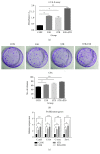Mechanical Stretch Promotes the Osteogenic Differentiation of Bone Mesenchymal Stem Cells Induced by Erythropoietin
- PMID: 31360172
- PMCID: PMC6642771
- DOI: 10.1155/2019/1839627
Mechanical Stretch Promotes the Osteogenic Differentiation of Bone Mesenchymal Stem Cells Induced by Erythropoietin
Abstract
Introduction: The effects of erythropoietin (EPO) on the behaviors of bone marrow mesenchymal stem cells (BMSCs) subjected to mechanical stretch remain unclear. This study was therefore aimed at establishing the dose-response effect of EPO stimulation on rat BMSCs and investigating the effects of mechanical stretch combined with EPO on the proliferation and osteogenic differentiation of BMSCs.
Material and methods: The proliferation and osteogenic differentiation of rat BMSCs were examined and compared using EPO with different concentrations. Thereafter, BMSCs were subjected to 10% elongation using a Flexcell strain unit, combined with 20 IU/ml EPO. The proliferation of BMSCs was detected by Cell Counting Kit-8, colony formation assay, and cell cycle assay; meanwhile, the mRNA expression levels of Ets-1, C-myc, Ccnd1, and C-fos were detected by reverse transcription and real-time quantitative PCR (qPCR). The osteogenic differentiation of BMSCs was detected by alkaline phosphatase (ALP) staining, and the mRNA expression levels of ALP, OCN, COL, and Runx2 were detected by qPCR. The role of the extracellular signal-regulated kinases 1/2 (ERK1/2) in the osteogenesis of BMSCs stimulated by mechanical stretch combined with 20 IU/ml EPO was examined by Western blot.
Results: Our results showed that effects of EPO on BMSCs included a dose-response relationship, with the 20 IU/ml EPO yielding the largest. Mechanical stretch combined with 20 IU/ml EPO promoted proliferation and osteogenic differentiation of BMSCs. The increase in ALP, mineral deposition, and osteoblastic genes induced by the mechanical stretch-EPO combination was inhibited by U0126, an ERK1/2 inhibitor.
Conclusion: EPO was able to promote the proliferation and osteogenic differentiation of BMSCs, and these effects were enhanced when combined with mechanical stretch. The underlying mechanism may be related to the activation of the ERK1/2 signaling pathway.
Figures






Similar articles
-
HIF-1α-TWIST pathway restrains cyclic mechanical stretch-induced osteogenic differentiation of bone marrow mesenchymal stem cells.Connect Tissue Res. 2019 Nov;60(6):544-554. doi: 10.1080/03008207.2019.1601185. Epub 2019 Apr 22. Connect Tissue Res. 2019. PMID: 30938209
-
Effect of porous tantalum on promoting the osteogenic differentiation of bone marrow mesenchymal stem cells in vitro through the MAPK/ERK signal pathway.J Orthop Translat. 2019 Apr 15;19:81-93. doi: 10.1016/j.jot.2019.03.006. eCollection 2019 Oct. J Orthop Translat. 2019. PMID: 31844616 Free PMC article.
-
Fak silencing impairs osteogenic differentiation of bone mesenchymal stem cells induced by uniaxial mechanical stretch.J Dent Sci. 2019 Sep;14(3):225-233. doi: 10.1016/j.jds.2019.03.001. Epub 2019 Mar 20. J Dent Sci. 2019. PMID: 31528249 Free PMC article.
-
The Effect of Uniaxial Mechanical Stretch on Wnt/β-Catenin Pathway in Bone Mesenchymal Stem Cells.J Craniofac Surg. 2017 Jan;28(1):113-117. doi: 10.1097/SCS.0000000000003252. J Craniofac Surg. 2017. PMID: 27922964
-
Low-magnitude vibration induces osteogenic differentiation of bone marrow mesenchymal stem cells via miR-378a-3p/Grb2 pathway to promote bone formation in a rat model of age-related bone loss.FASEB J. 2020 Sep;34(9):11754-11771. doi: 10.1096/fj.201902830RRR. Epub 2020 Jul 11. FASEB J. 2020. PMID: 32652777
Cited by
-
Hypoxia-Inducible Factors Signaling in Osteogenesis and Skeletal Repair.Int J Mol Sci. 2022 Sep 23;23(19):11201. doi: 10.3390/ijms231911201. Int J Mol Sci. 2022. PMID: 36232501 Free PMC article. Review.
-
The role of mechanobiology in bone and cartilage model systems in characterizing initiation and progression of osteoarthritis.APL Bioeng. 2022 Jan 5;6(1):011501. doi: 10.1063/5.0068277. eCollection 2022 Mar. APL Bioeng. 2022. PMID: 40746901 Free PMC article. Review.
-
Mechanical tension-induced Dalrd3 elevation enhances osteogenic differentiation of bone suture stem cells by upregulating Id3 translation.Stem Cell Res Ther. 2025 Jun 17;16(1):309. doi: 10.1186/s13287-025-04380-9. Stem Cell Res Ther. 2025. PMID: 40528244 Free PMC article.
-
Calcium response in bone cells at different osteogenic stages under unidirectional or oscillatory flow.Biomicrofluidics. 2019 Nov 21;13(6):064117. doi: 10.1063/1.5128696. eCollection 2019 Nov. Biomicrofluidics. 2019. PMID: 31768203 Free PMC article.
-
Fluid Shear Stress Regulates Osteogenic Differentiation via AnnexinA6-Mediated Autophagy in MC3T3-E1 Cells.Int J Mol Sci. 2022 Dec 11;23(24):15702. doi: 10.3390/ijms232415702. Int J Mol Sci. 2022. PMID: 36555344 Free PMC article.
References
-
- Mumford J. E., Simpson A. H. R. W. Management of bone defects: a review of available techniques. The Iowa Orthopaedic Journal. 1990;12:42–49.
LinkOut - more resources
Full Text Sources
Research Materials
Miscellaneous

